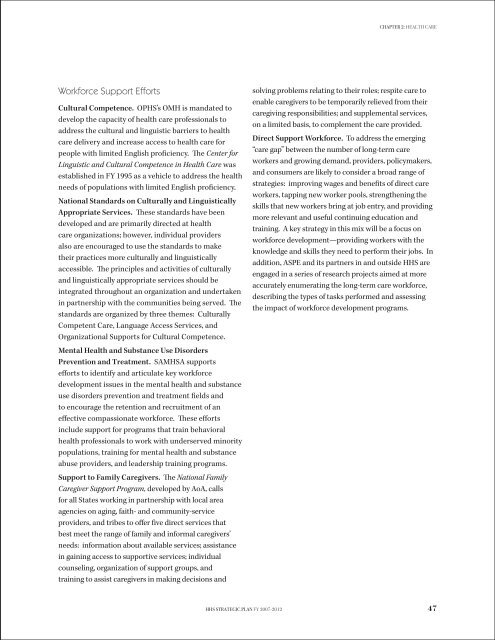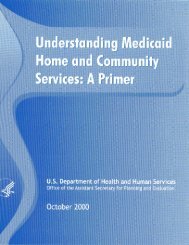STRATEGIC PLAN - ASPE - U.S. Department of Health and Human ...
STRATEGIC PLAN - ASPE - U.S. Department of Health and Human ...
STRATEGIC PLAN - ASPE - U.S. Department of Health and Human ...
Create successful ePaper yourself
Turn your PDF publications into a flip-book with our unique Google optimized e-Paper software.
CHAPTER 2: <strong>Health</strong> careWorkforce Support EffortsCultural Competence. OPHS’s OMH is m<strong>and</strong>ated todevelop the capacity <strong>of</strong> health care pr<strong>of</strong>essionals toaddress the cultural <strong>and</strong> linguistic barriers to healthcare delivery <strong>and</strong> increase access to health care forpeople with limited English pr<strong>of</strong>iciency. The Center forLinguistic <strong>and</strong> Cultural Competence in <strong>Health</strong> Care wasestablished in FY 1995 as a vehicle to address the healthneeds <strong>of</strong> populations with limited English pr<strong>of</strong>iciency.National St<strong>and</strong>ards on Culturally <strong>and</strong> LinguisticallyAppropriate Services. These st<strong>and</strong>ards have beendeveloped <strong>and</strong> are primarily directed at healthcare organizations; however, individual providersalso are encouraged to use the st<strong>and</strong>ards to maketheir practices more culturally <strong>and</strong> linguisticallyaccessible. The principles <strong>and</strong> activities <strong>of</strong> culturally<strong>and</strong> linguistically appropriate services should beintegrated throughout an organization <strong>and</strong> undertakenin partnership with the communities being served. Thest<strong>and</strong>ards are organized by three themes: CulturallyCompetent Care, Language Access Services, <strong>and</strong>Organizational Supports for Cultural Competence.Mental <strong>Health</strong> <strong>and</strong> Substance Use DisordersPrevention <strong>and</strong> Treatment. SAMHSA supportsefforts to identify <strong>and</strong> articulate key workforcedevelopment issues in the mental health <strong>and</strong> substanceuse disorders prevention <strong>and</strong> treatment fields <strong>and</strong>to encourage the retention <strong>and</strong> recruitment <strong>of</strong> aneffective compassionate workforce. These effortsinclude support for programs that train behavioralhealth pr<strong>of</strong>essionals to work with underserved minoritypopulations, training for mental health <strong>and</strong> substanceabuse providers, <strong>and</strong> leadership training programs.Support to Family Caregivers. The National FamilyCaregiver Support Program, developed by AoA, callsfor all States working in partnership with local areaagencies on aging, faith- <strong>and</strong> community-serviceproviders, <strong>and</strong> tribes to <strong>of</strong>fer five direct services thatbest meet the range <strong>of</strong> family <strong>and</strong> informal caregivers’needs: information about available services; assistancein gaining access to supportive services; individualcounseling, organization <strong>of</strong> support groups, <strong>and</strong>training to assist caregivers in making decisions <strong>and</strong>solving problems relating to their roles; respite care toenable caregivers to be temporarily relieved from theircaregiving responsibilities; <strong>and</strong> supplemental services,on a limited basis, to complement the care provided.Direct Support Workforce. To address the emerging“care gap” between the number <strong>of</strong> long-term careworkers <strong>and</strong> growing dem<strong>and</strong>, providers, policymakers,<strong>and</strong> consumers are likely to consider a broad range <strong>of</strong>strategies: improving wages <strong>and</strong> benefits <strong>of</strong> direct careworkers, tapping new worker pools, strengthening theskills that new workers bring at job entry, <strong>and</strong> providingmore relevant <strong>and</strong> useful continuing education <strong>and</strong>training. A key strategy in this mix will be a focus onworkforce development—providing workers with theknowledge <strong>and</strong> skills they need to perform their jobs. Inaddition, <strong>ASPE</strong> <strong>and</strong> its partners in <strong>and</strong> outside HHS areengaged in a series <strong>of</strong> research projects aimed at moreaccurately enumerating the long-term care workforce,describing the types <strong>of</strong> tasks performed <strong>and</strong> assessingthe impact <strong>of</strong> workforce development programs.HHS Strategic Plan FY 2007-201247
















